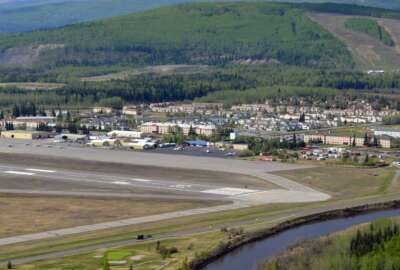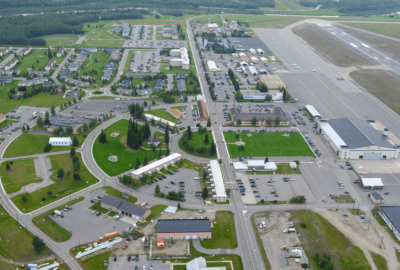What the Army is doing to improve housing
Army housing has been a sore subject for residents, Army leadership and Congress. But there's been progress.
Best listening experience is on Chrome, Firefox or Safari. Subscribe to Federal Drive’s daily audio interviews on Apple Podcasts or PodcastOne.
It’s the world’s premier expeditionary force. Yet every U.S. Army soldier has a home or a home base. Often that home is in housing provided by the Army itself. Army housing has been a sore subject for residents, Army leadership and Congress. But there’s been progress. For an update on this and other matters at the Association of the U.S. Army conference, the Federal Drive with Tom Temin talked with the commander of the Installation Management Command, Lieutenant General Omar Jones.
Interview transcript:
Tom Temin: You have moved up a notch from deputy commander to commander; got an extra star on the shoulder? So what’s the difference between being the commander and the deputy commander?
Omar Jones: Remember what President Truman used to say the buck stops here. So the buck stops here. But I am just so grateful to the Army leadership that gave me a year last year to be the deputy. And you met the team, got to understand the science. There’s a lot of science to running installations around the world. And then just privileged. I was nominated and and confirmed by the Senate to both get promoted and then take command. Took command right at the fourth July weekend. And, Tom, I gotta say, I think I have the best job in the Army. We touch everything the Army does. soldiers and families all the way to deploying forces to get off installations we have to go around the world. It is incredible. I am enjoying every day.
Tom Temin: And maybe update the website that you are actually there as commander.
Omar Jones: That’d be good. Okay. Slow in some things. That’s fair.
Tom Temin: All right. Let’s talk about housing, that’s a big bugaboo. We talked about it last year, there have been lots of improvements you’ve made. Some certain homes and certain places have been specifically refurbished. The AUSA study just came out. Mixed reviews on resident’s feelings, attitudes toward the housing, give us the update on where you’re headed here.
Omar Jones: It’s interesting, and it goes across the command in so many areas that are really the quality of life, all the trends are going in the right direction. And we have, as you’ve heard, incredibly resourced, and emphasis from our senior leaders, the secretary of the Army, the chief staff, the army, in terms of quality of life, taking care of our people, and in housing, right right at the top of that list. But even though the trends are in the right direction, we have to make sure every single family is taken care of. What I bring to this job, the perspective I take, so I’ve been in uniform 30 years. I have three sons two are serving today. One is getting married in two weeks, and he’s marrying another service member. So I always think about, we may have 100,000 homes that the Army is responsible for. And if one family is not getting taken care of I look at that from what if that was my family? And we’ve got to make sure we take care of all of them. But the trends are going the right direction, we’ve invested about $1.6 billion over the past three years of the privatized housing companies to improve quality of housing, we think we’re going to see another I’m sorry, $800 million over the past three years, another $1.6 billion of the next three years just to improve the quality of housing. It needs to be the right quality, it needs to be safe, needs to be a place that people feel proud of. And then they’re happy to live there. So I think we’re heading the right direction. But we’ve got work to do. I mean, we’ve got to keep going forward with that.
Tom Temin: And I also wanted to ask you about the other kind of big issue when it comes to installations. And that is climate. Absolutely. There’s the political reality, then there’s the actual climate reality, sometimes those things diverge. But we’ve seen flooding, we’ve seen installations affected. What I guess the question is how to begin with how do you prioritize what you need to do because some parts are high up above the ocean, some parts are right hard by you know the seas?
Omar Jones: Well, it actually starts with our mission. The Army exists to fight and win our nation’s wars, to do what our nation asks us to do. And when you start there, then we get back to the installations, they have to be resilient, because all the Army forces that deploy deploy from our installations. So how can we make sure that if we were to lose power, that the installation still has power? If we will lose water, the installation still has water, to do all the things the country needs the army to do. So that actually makes the prioritization pretty clean when we look at it to make sure that, you know, from a resiliency perspective, are our installations able to support what the Army and the joint force needs to do for the nation? So we look at climate change and climate risk, whether it’s storms, whether it’s increasing utility costs, whatever it happens to be, we look at can we do the mission the nation needs the army to do, and are we maintaining that regardless of what the challenges are going in the future? And so that drives our prioritization.
Tom Temin: We’re speaking with Lieutenant General Omar Jones, commander of the Installation Management Command, and just update us on that. You mentioned utilities and power and a lot of the installations and bases we’re looking at solar. Anyway, of self-generating that is to be not necessarily on the commercial grid. Is what’s going on there?.
Omar Jones: We made tremendous progress over the past year, we’ve gotten great policy from the Army headquarters and we’re implementing that policy across all of the installations. And again, if you start with resilience, then it gets to renewables and a lot of ways whether it is solar, whether there’s other opportunities out there, but we’re looking at all the possible tools to make sure that we can reduce costs. So we can make sure we’re being efficient with the money the taxpayers have given, Department of Defense has given to the Army, but also that we can do the mission that we’re asked to do. And it is incredible ingenuity that’s out there, and in many cases, partnering with industry, partnering with local communities. And we’re seeing great results because of those.
Tom Temin: So are there windmills going in, or solar arrays going in here and there?
Omar Jones: All the above, but the primary one right now is is a lot of solar. We just put a solar array down in Fort Bragg, North Carolina, actually floating solar array on a local lake. So the solar panels are out on the lake. And it is given us great resiliency there for one of our really important installations.
Tom Temin: Yeah, that’s a big one. So you have to have metrics in place to understand?
Omar Jones: Absolutely. Are we being more resilient than we were yesterday? Are we being more efficient than we were yesterday? And we look at those all the time.
Tom Temin: Because that resiliency could result in higher costs per kilowatt say, then you have to decide what value matters more.
Omar Jones: You do. And that’s exactly how we look at it.
Tom Temin: All right, and well COVID too. And that’s a big installation issue, because this is an ever-changing situation. It’s mostly behind in the nation, but not fully. What’s the status on installations? What are the protocols, what are you seeing in terms of infections, and so on?
Omar Jones: Well, the approach the Army has taken is to really empower our senior commanders. So those general officers and senior leaders that are out there on the installations to make those decisions based on what the community spread looks like in the local communities outside the installation, as well as on the installation and then set the health protection level. And then from there, make sure they’re taking all the appropriate precautions. So far, all the trends are going the right way. Most of our installations are what is called health protection condition A, which is our almost our lowest condition. And so it’s we’re a lot better situation where a year ago, or definitely two or three years ago. But let me talk COVID one moment, if I could for you. One of the things that I am most proud of this command is the childcare, child development we provide to Army family members. And the reason I highlight that, because when you look back during the pandemic, the nation still had things that needed its Army to do. And the way we were able to support that was we kept our child development centers open, so that single soldiers, so soldiers were both both parents were working, they were still able to take their kids to childcare. In many cases, the heroes are those childcare workers who come in each and every day, and taking care of those children so that their soldier parents are able to do their job. And every time I travel, and I travel all over to go see our installations, I always stop by to thank our childcare workers, because it really is the gold standard of childcare across our country. And those folks are incredible.
Tom Temin: Yeah, well, having raised a couple myself and I have four grandchildren. Those people should have halos.
Omar Jones: I absolutely agree with you.
Tom Temin: All right, so what are you hoping for in the next year? What do you want this whole Installation Management Command to look like?
Omar Jones: That we can keep taking care of the Army. My focus will continue to be on Army people. Making sure that we take care of the infrastructure that the people need for their quality of life, because when you look at quality of life, when you take care of our people, and they go back and talk to folks in their local communities, and they can tell them that the Army really does put its money where its mouth is. The Army really does invest in all of the things that take care of your quality of life, because that takes care of our readiness. And that’s what the Army needs to do. And that’s where my focus is. And again, there’s no better job in the Army. I’m thoroughly enjoying it, Tom.
Eric White: Lieutenant General Omar Jones is commander of the Army’s Installation Management Command. Speaking at the AUSA conference with Tom Temin.
Copyright © 2025 Federal News Network. All rights reserved. This website is not intended for users located within the European Economic Area.
Tom Temin is host of the Federal Drive and has been providing insight on federal technology and management issues for more than 30 years.
Follow @tteminWFED





